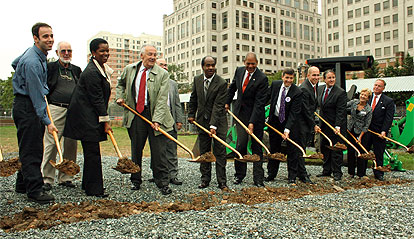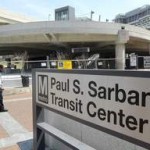 Costs for the Silver Spring Transit Center have already quadrupled
Costs for the Silver Spring Transit Center have already quadrupled
Instead of serving 100,000 commuters per day as promised, the Silver Spring Transit Center sits empty and fenced off four years after its promised completion date.
Sep 9, 2014 – More Money Needed For Still Unopened Silver Spring Transit Center – Post
Aug 16, 2014 – Still No Opening Date For Silver Spring Transit Center – Post
May 29, 2014 – Repairs On Troubled Silver Spring Transit Center To Resume – Post
Mar 20, 2014 – Doug Duncan Calls For Answer On Silver Spring Transit Center – Post
Sep 6, 2013 – Silver Spring Transit Center Fiasco To Get Extra Concrete To Attempt Fix – Post
Sep 6, 2013 – New Leaks Discovered In Silver Spring Transit Center Fiasco – NBC
May 20, 2013 – How Silver Spring Transit Center Plan Grew Into A Fiasco – Post
Feb 26, 2013 – Dispute Over Stalled Silver Spring Transit Center Intensifies – ENR
By Mark Uncapher, Montgomery County Republican Chairman
Montgomery County’s Silver Spring Transit Center was once supposed to open in 2009 and cost $30 million. It was expected to be a hub for Metro, MARC trains and buses serving nearly 100,000 people a day.
Over two decades after the county first bought the land and more than six years after construction began, the Silver Spring Transit Center remains empty and unused behind a chain-link fence.
Costs have ballooned to over $120 million, and the Center remains closed because of safety concerns due to structural and design problems. The need for greater steel support in the roadway has caused the project to be delayed.
Metro was originally going to take over the facility from Montgomery County. However in April it told the county they will not operate the center at all, regardless of repairs being made. Metro said the deficiencies in the building “are of the magnitude and severity, that even if repaired, would unnecessarily place an inordinate maintenance burden onto WMATA should the facility be accepted.” Even if the building is fixed and while Metro may run buses in it, Metro wants its name off of the building.
For months now, much sound and fury has been expended by county officials to avoid addressing the source of the problem head-on.
For example, just this week by the County Council’s Office of Legislative Oversight issued a report comparing the county’s design and construction policies against those in 13 other jurisdictions. The Council’s office decided that the county policies are among the best practices in the industry. This may be interesting in an academic way. However, not only did the report not investigate if those practices are being implemented properly, it did not directly address the Silver Spring fiasco.
Since the problems first surfaced over the past three years ago, the county has tried mightily to evade any attention being paid to its own flawed, complex design for the Center. County officials have tried to shift blame toward the builders and private inspectors.
Earlier this year the County Council convened a hearing to consider the issue, after learning about key developments in the Washington Post and being blindsided by the Leggett administration. They asked County Executive Leggett meet with the Council in person for explanations. The County Executive declined, citing a conflicting photo opportunity with Governor O’Malley. And apparently neither the Council nor Leggett were unable to come up with an alternative time to publicly meet.
When county officials have testified, according some accounts, they have misrepresented the findings from their own follow-up engineering study. County officials claimed at a council hearing that they no idea that the concrete did not have additional support, despite their own study which noted that the project’s original design was flawed because it failed to require the necessary extra support, referred to as “post-tensioning in the pour strips.”
The Washington Post has shed more light on the underlying problem, reporting specifically on the initial project requirements and design: “That complexity set off alarms even before a contractor was selected to build the center. The design, by the global engineering giant Parsons Brinckerhoff, and the county’s specifications were so elaborate – the document distributed to prospective builders was more than 2,200 pages long – that some firms were leery of bidding for the work.”
“They acted like they were building the Taj Mahal,” said a local construction executive who asked not to be named to avoid jeopardizing his ties to the county. “[1] Only two companies, Foulger-Pratt and Clark Construction, actually bid on the project.
So who is responsible for the Silver Spring Transit Center’s flawed design, especially the failure to require adequate reinforcement? Certainly the design firm, Parsons Brinckerhoff, should be held accountable. But questions should also be directed within the county government and the Department of Transportation (DOT). More specifically, within DOT is the Division of Transportation Engineering, Planning & Design.
_______________________________________________________________
Silver Spring Transit Center
Location:
8400 Colesville Road, Silver Spring MD 20910
Colesville Road and the Metrorail Overpass, Silver Spring, MD
Approximately three acres, or about half of the area formerly occupied by the bus loops and short term parking.
During construction, the bus stops have been temporarily relocated along neighboring streets. Parking is available in several nearby public parking garages.
Project
A three-level multi modal transit center is being built by Montgomery County, MD. When completed, the Transit Center will provide expanded bus facilities and connectivity to Metrorail, Metrobus, MARC Rail, Ride On Bus, and intercity buses. There will be multiple points of entry for pedestrians from three directions, and access from two bike trails. Funding of approximately $90 million is being provided by Montgomery County, the State of Maryland, and the federal government. Metro will operate the completed Transit Center. A three phase joint development project is planned next to the Transit Center (see separate web page).
Approximately 32 bus bays, serving both Metrobus and Ride On buses (certain bus bays may be allocated to one articulated bus or two shorter buses, depending on future transit needs)
20 short term parking spaces including provision for car sharing service
MARC commuter rail station
Intercity bus station
Bicycle storage facilities
Metropolitan Branch (bike) Trail will pass immediately next to the Transit Center
Capitol Crescent (bike) Trail will be across the street
Dedication of approximately .26 acres for the triangular Gene Lynch Urban Park
Right of way area has been provided for a future connection to the Purple Line light rail line which is planned to connect Bethesda with New Carrollton; Metro will also dedicate right of way for a new street connecting Bonifant and Ripley Streets (to be built by others)
Timeline
Metro/Montgomery County Memorandum of nderstanding (“MOU”) November, 2004
Metro/Montgomery County/ Maryland National Park and Planning Commission MOU April, 2008
Amended and Restated Metro/Montgomery County MOU September, 2008
Project Coordination Agreement September, 2008
Authorization to Proceed with construction October, 2008
Anticipated Completion Late 2012

